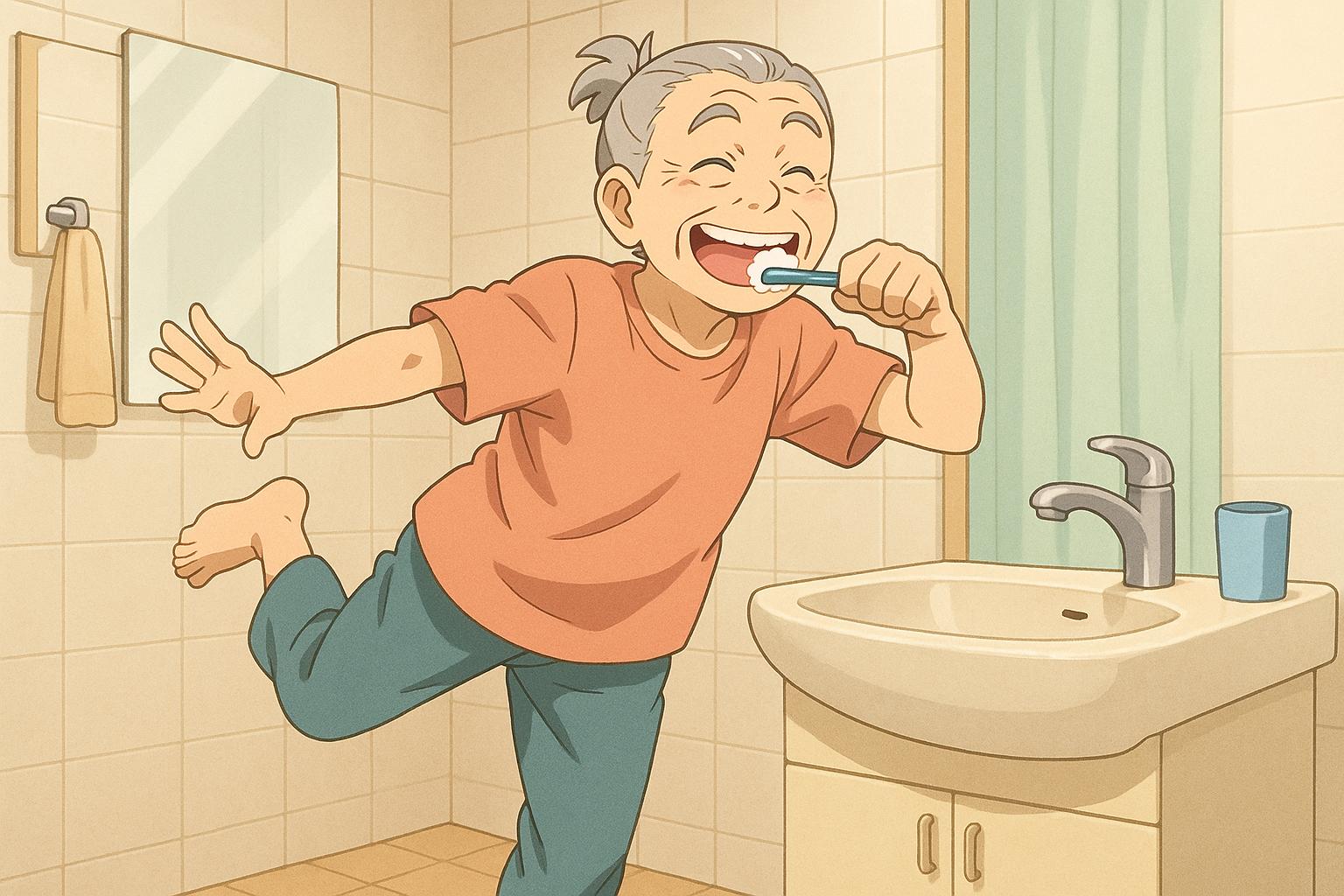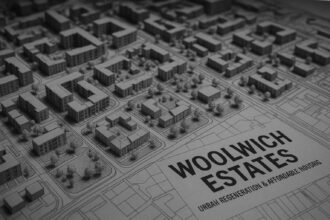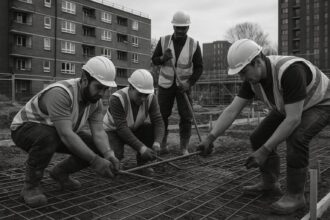Simple home tests like balancing on one leg or brushing your teeth are gaining popularity as quick checks on ageing, but experts stress a broader approach—including mental agility and emotional wellbeing—is essential for truly understanding and enhancing the ageing process.
A few years ago, social media users were challenged to demonstrate their agility by standing up from the floor without using their hands, a feat that sparked fascination and curiosity about the capabilities of ageing bodies. Today, a new trend has emerged: balancing on one leg while brushing your teeth. These light-hearted “tests” claim to reveal valuable insights into our aging process, but how effective are they in providing a comprehensive picture of our wellbeing?
When discussing “ageing well,” we often focus on both physical and psychological aspects of health, which encompass hedonic wellbeing—feeling good—and eudaimonic wellbeing—finding purpose in life. Engaging in various activities and self-monitoring can significantly influence both dimensions.
Ageing is a multifaceted journey, incorporating physical, cognitive, emotional, and social changes. It isn’t merely about grip strength or walking speed; rather, it encapsulates an array of factors that together inform our health status. One popular measure of ageing is walking speed, noted for its stark predictive power concerning longevity. A notable study suggests that those who maintain a walking speed surpassing 1.32 metres per second are less likely to face mortality in the subsequent three years. This concept is somewhat light-heartedly dubbed “too fast for the Grim Reaper to catch.”
Conversely, a slower walking pace—under 0.8 metres per second—may indicate sarcopenia, characterised by muscle mass and strength decline, which are substantial markers of age-related deterioration. While these indicators can be telling, they often require specialised equipment that isn’t readily available for home use. Most general practitioners lack tools like grip-strength dynamometers, although they can efficiently monitor basic functional tests such as timing the number of times one can stand up from a seated position.
So, how can individuals effectively track their ageing process at home? To do so, it is crucial to adopt a holistic view that extends beyond physical health. Mental agility, emotional resilience, and social connectivity are equally paramount. A beneficial approach is to gauge your cognitive fitness through a series of self-administered tests.
For instance, the Trail Making Test, which requires participants to connect numbers and letters in sequence while timing their completion, examines cognitive agility and task-switching capabilities. Similarly, the Stroop task, which demands saying the colour of a word rather than the word itself—such as saying “red” for the word “blue” printed in red ink—challenges cognitive processing under competing stimuli. Additionally, a dual-task challenge, where one walks at a normal speed while counting backwards from 100 in threes, can reveal cognitive strain when alterations in walking speed occur.
The appeal of these tests lies in their simplicity, though determining personal improvement can be elusive. For instance, tests measuring single-leg stance can fluctuate significantly across time, and improvements may reflect practice rather than genuine ageing progress. In contrast, measures like grip strength tend to exhibit more gradual changes. Experts recommend conducting initial trials of these tests, followed by regular monthly assessments, to accurately track any meaningful developments.
Ultimately, there is no singular assessment or scoring system that captures the complexities of ageing. Rather, consider the process akin to piecing together a jigsaw puzzle, wherein physical health, mental acuity, emotional stability, and social ties intertwine. Performance in tests today may not predict future abilities, as some physiological changes may lie beyond individual control.
Perhaps the most telling indicator of successful aging is subjective: how engaged and content individuals feel in their lives. Tools like the Scale of Positive and Negative Experience can be invaluable in evaluating emotional wellbeing. This concise, 12-question survey addresses everyday feelings, providing insights into the pleasurable and meaningful dimensions of one’s life.
In conclusion, ageing well transcends mere speed tests or memory challenges. It hinges on a deeper understanding of oneself—physically, mentally, and emotionally. Any attempts at measuring ageing should be accompanied by an exploration of personal values and a commitment to making subtle, impactful lifestyle adjustments. Engaging in playful activities, such as balancing on one leg, may enhance wellbeing, but it is equally important to assess and nurture one’s cognitive abilities and emotional connections every step of the way.
Marco Arkesteijn, a Lecturer in Sport and Exercise Biomechanics, and Alexander Nigel William Taylor, a Lecturer in the Department of Psychology at Aberystwyth University, emphasise the importance of a comprehensive approach towards understanding the aging experience.
Reference Map
- Paragraph 1: [1], [2]
- Paragraph 2: [1]
- Paragraph 3: [1], [3]
- Paragraph 4: [1]
- Paragraph 5: [1], [6]
- Paragraph 6: [1], [5]
- Paragraph 7: [1], [2]
- Paragraph 8: [1], [7]
- Paragraph 9: [1]
- Paragraph 10: [1], [4]
- Paragraph 11: [1]
- Paragraph 12: [1]
- Paragraph 13: [1]
Source: Noah Wire Services
- https://www.independent.co.uk/life-style/health-and-families/ageing-population-test-diy-guide-b2755066.html – Please view link – unable to able to access data
- https://www.livemint.com/science/health/five-do-it-yourself-tests-to-monitor-your-health-as-you-get-older-11658666785603.html – This article discusses five self-administered tests to monitor health as one ages. It includes the one-legged standing test, sit-to-stand test, six-minute walk test, cognitive test, and grip strength test. Each test is explained with instructions and the health implications of the results. The article emphasizes that these tests are not substitutes for professional medical assessments and advises consulting a doctor before performing them.
- https://www.aarp.org/health/healthy-living/info-2024/how-well-are-you-aging.html – AARP presents five tests to assess physical fitness levels: the 1-mile walk, sit and reach assessment, push-up test, squat test, and one-legged balance test. Each test is detailed with instructions, the importance of the test, and how to improve scores. The article highlights the significance of these tests in evaluating overall health and provides guidance on maintaining or improving physical fitness.
- https://www.radhakrishnatemple.net/blog/5-simple-exercises-to-gauge-aging-health-and-vitality/ – This blog post outlines five simple exercises to gauge aging health and vitality, including the stand on one leg test, chair sit-to-stand test, walking speed test, push-up challenge, and grip strength test. Each exercise is explained with its purpose, how to perform it, and the health implications of the results. The post emphasizes the importance of these tests in monitoring health as one ages.
- https://www.greensorganic.co.uk/blogs/natural-news/evaluating-fitness-for-your-age-seven-simple-home-tests – Golden Greens Organic Ltd provides seven simple home tests to evaluate fitness for one’s age, including the chair sit-to-stand test, walking speed test, push-up challenge, grip strength test, stair climb time, one-leg balance test, and stair climb time. Each test is described with instructions, health implications, and scoring details. The article encourages regular monitoring and professional guidance to maintain or improve health and fitness.
- https://www.agefriendlycare.psu.edu/tips-tools – Penn State’s Age-Friendly Care initiative offers tips and tools for healthcare professionals, including assessment tools like the Timed Up & Go (TUG) test, Tinetti Assessment Tool, Katz Index of Independence in Activities of Daily Living (Katz ADL), and the Lawton Instrumental Activities of Daily Living (IADL) Scale. These tools are designed to assess mobility, balance, walking ability, fall risk, and functional status in older adults.
- https://agingisbeautiful.com/2016/12/18/6-physical-tests-to-see-how-well-youre-aging/ – Aging Is Beautiful outlines six physical tests to assess aging: walking speed test, blinded one-leg balance test, hand grip strength test, chair sit-to-stand test, stair climb time, and stair climb time. Each test is explained with instructions, health implications, and scoring details. The article emphasizes the importance of these tests in monitoring health and provides guidance on maintaining or improving physical fitness.
Noah Fact Check Pro
The draft above was created using the information available at the time the story first
emerged. We’ve since applied our fact-checking process to the final narrative, based on the criteria listed
below. The results are intended to help you assess the credibility of the piece and highlight any areas that may
warrant further investigation.
Freshness check
Score:
9
Notes:
The narrative references recent trends such as social media challenges from a few years ago and current recognised ageing tests, with no outdated references to individuals who have changed roles or passed away. It does not appear recycled from older content but integrates contemporary research and expert commentary, indicating high freshness. No signs of it being a press release which would imply planned timed dissemination.
Quotes check
Score:
8
Notes:
Direct quotes are attributed to Marco Arkesteijn and Alexander Nigel William Taylor, both lecturers at Aberystwyth University. No earlier online sources of these exact quotes were found, suggesting originality or first publication here, increasing credibility. The experts’ credentials add weight, though the quotes are general emphasising a comprehensive approach rather than factual claims requiring verification.
Source reliability
Score:
9
Notes:
The narrative originates from a well-known UK publication with a strong reputation for quality lifestyle and health reporting. This typically implies editorial standards and fact-checking protocols are in place, contributing to reliability. The involvement of academic experts further supports credibility.
Plausability check
Score:
9
Notes:
The claims about ageing tests, including walking speed and cognitive assessments like the Trail Making Test and Stroop task, align with established scientific understanding and widely accepted clinical measures. The emphasis on multifaceted ageing and the difficulty of singular tests is plausible and consistent with current gerontology views. The article’s claims can be verified with scientific literature.
Overall assessment
Verdict (FAIL, OPEN, PASS): PASS
Confidence (LOW, MEDIUM, HIGH): HIGH
Summary:
The narrative presents up-to-date, plausible information corroborated by recognised scientific tests and expert opinions. The lack of older recycled material or press release indicators alongside a reputable publication origin and original expert quotes strongly supports its reliability and freshness.













